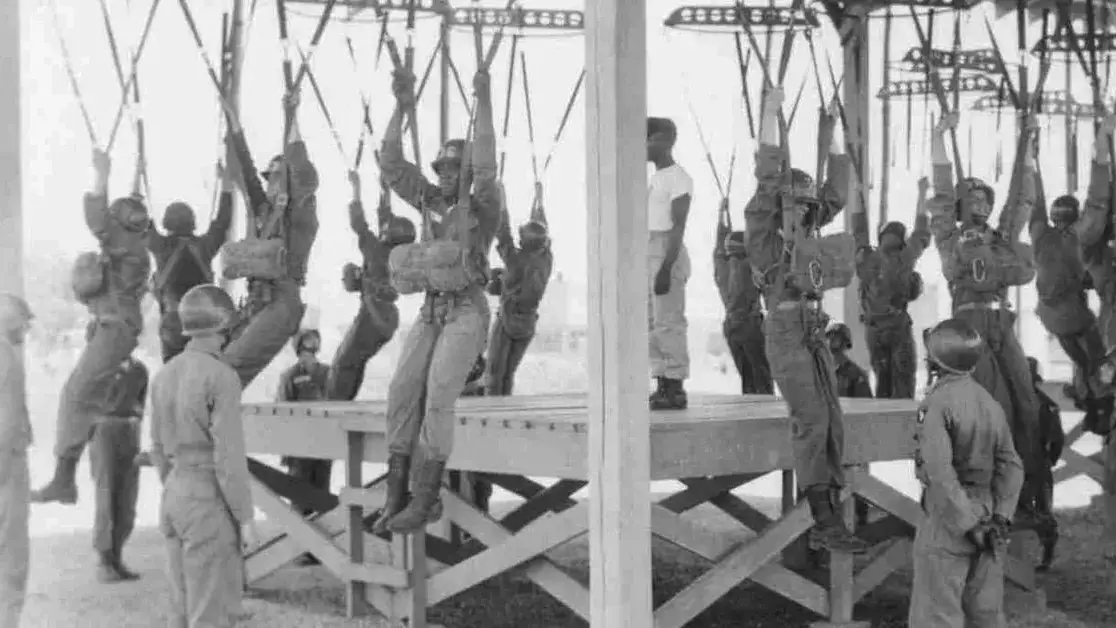Here are 10 things everyone experiences in jump school

SUMMARY
The U.S. Army Airborne School at Fort Moore, Georgia is where U.S. military members of all branches go to become military parachutists. The school is three weeks of intense physical drills, training on towers, and of course, "jumping out of a perfectly good airplane" five times to earn the coveted silver parachute badge (also known as "jump wings").
Here are 10 things Airborne students will encounter when going through Jump School
1. Black Hats
An Airborne instructor's nametag may read "Jones" but students will address him or her as "Sergeant Airborne." New Airborne trainees are received by the school's instructors known as "Black Hats," because of their headgear, a simple black baseball cap with their rank and wings display on the cap.
The instructors are mostly Army personnel, but the Marine Corps Air Force, and Navy also provide instructors since the school is open to all eligible DOD service members. Black Hats are skilled parachutists who are responsible for training Airborne students, and they do with 'tough love.' They will make their students repeat physical drills and exercises over and over until they get it right.
No matter how exhausting, they won't stop until a student gets it right. They are doing it for the trainees own well-being.
2. The Airborne Shuffle
Not to be confused with the popular dance the 'Cupid shuffle' or the Chicago Bears Super Bowl shuffle, the Airborne shuffle is not a dance nor is it fun. This shuffle refers to the pace or speed of a formation run during Airborne school. It is typically about a 9-minute mile.
The shuffle is meant to build stamina, not speed. At Airborne School, trainees run everywhere especially in combat boots or with their equipment. The Airborne shuffle is also commonly known for the short choppy steps students take on the aircraft before the jump out, just like the cadence "Stand up, Hook up, Shuffle to the door."
3. Wearing Helmets all day
At Jump School, aspiring paratroopers will wear their helmet everywhere they go. Students will run and train with it on every day. The chin strip and helmet pads will reek so bad after the first week of training that a squirt of Febreze is simply not enough to contain the smell of sweat and bacteria.
4. Falling all day
Airborne students will spend a lot of time hitting the ground during Jump School. Learning how to properly fall during a parachute landing is a core fundamental taught at the Basic Airborne Course. This is especially true when doing parachute landing fall (PLF) drills. Trainees will jump off platforms of different heights into large pits over and over until they get it right. Airborne students can expect to do hundreds of PLFs before they leave the school.

Along with PLFs, trainees will jump from tall towers like the 34-foot tower to learn proper aircraft exiting techniques and the iconic 250-foot tower, although not all Airborne class get to do the tower.
Just remember to "keep your feet and knees together!"
5. The smell of Bengay in the morning
Before long, the smell of Bengay, the over-the-counter analgesic cream used to relieve muscle and joint pain, will fill the barracks each morning to help students with their joint and muscle pain.
6. Swing Landing Trainer
The Swing Landing Trainer is not fun. Students are strapped into a harness to step off a platform and swing back and forth. The discomfort experienced on this device when swinging, especially for male students, is terrible. Students will continue to swing on the harness until they are released by the Black Hats. Trainees must perform several proper PLFs to pass this stage of training.
Most hit the ground like a stack of potatoes.
7. "Hurry up and wait" goes to a whole new level
Finally, it's jump week... but the wait isn't over. Students will wake up early, run to the chute shed, rig up, and just wait and wait for many hours. Students are not allowed to sleep or talk as they wait. It's the ultimate example of "hurry up and wait."
8. A mix of emotions
Time to jump! There's certainly level of excitement and fear at this point, as jumpers hook up to the static line and prepare to jump. Some people question their judgement at this point, as butterflies flutter in their stomachs and thoughts of "why the hell am I doing this" circle in their head. For others, this is the best moment of their life!
9. Jumping Out
Probably the two most common reactions: "This is awesome" or "Holy Shit!"
10. Pinning of the Wings
After completing five parachute jumps, Lt. Col. Kay Wakatake has her wings pinned on by Sgt. 1st Class Raymond Richardson at Fort Benning, Georgia. (Photo by Captain Greg Peterson)
The pinning of parachute wings is the crowning achievement of three weeks of training. The badge is pinned (or slammed) on the graduate's chest. This rite of passage solidifies an individual as a member of the Airborne family. The best part of all of this: You're no longer a leg!
SHARE
